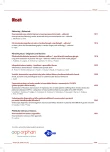The results of the RE- LY study promise more effective, safer and easier prevention of embolic complications in patients with non‑valvular atrial fibrillation
Authors:
J. Vojáček
Authors‘ workplace:
I. interní klinika Lékařské fakulty UK a FN Hradec Králové, přednosta prof. MU Dr. Jan Vojáček, DrSc., FESC, FACC
Published in:
Vnitř Lék 2009; 55(11): 1085-1088
Category:
Reviews
Overview
The RE-LY study compared dabigatran in the dose of 150 mg and 110 mg twice daily, without laboratory monitoring, with the conventional treatment with warfarin dosed according to INR in 18,113 patients with non‑valvular atrial fibrillation and high risk of embolisation. The incidence of cerebrovascular events and systemic embolisation was 1.69% per year in the warfarin group, compared to 1.53% per year in the 110 mg dabigatran group (relative risk 0.91; 95% CI 0.74– 1.11; p < 0.001 for non‑inferiority) and 1.11% per year in the 150 mg dabigatran (relative risk 0.66; 95% CI 0.53 – 0.82; p < 0.001 for superiority). Major bleeding occurred in 3.36% of patients per year in the warfarin group, compared to 2.71% of patients per year in the 110 mg dabigatran group (p = 0.003) and 3.11% of patients per year in the 150 mg dabigatran group (p = 0.31). Cerebral haemorrhagic events occurred in 0.38% of patients on warfarin per year, compared to 0.12% per year in the 110 mg dabigatran group (p < 0.001) and 0.10% per year in the 150 mg dabigatran group (p < 0.001). Mortality was 4.13% per year in the warfarin group, compared to 3.75% per year in patients on 110 mg dabigatran (p = 0.13) and 3.64% per year in patients on 150 mg dabigatran (p = 0.051). In conclusion, administration of dabigatran to patients with atrial fibrillation in the dose of 110 mg in the RE- LY study was associated with the same incidence of cerebrovascular events and systemic embolisations as with warfarin, while there was lower incidence of major bleeding complications. Dabigatran in the dose of 150 mg compared to warfarin led to reduction in the incidence of cerebral events and systemic embolisations with the same incidence of haemorrhagic complications.
Key words:
non‑valvular atrial fibrillation – dabigatran – warfarin – cerebrovascular event – systemic embolisation
Sources
1. Ezekowitz MD, Connolly S, Parekh A et al. Rationale and design of RE‑ LY: randomized evaluation of long‑term anticoagulant therapy, warfarin, compared with dabigatran. Am Heart J 2009; 157: 805– 810.
2. Greenlee RT, Vidaillet H. Recent progress in the epidemiology of atrial fibrillation. Review. Curr Opin Cardiol 2005; 20: 7– 14.
3. Go AS. The epidemiology of atrial fibrillation in elderly persons: the tip of the iceberg. Am J Geriatr Cardiol 2005; 14: 56– 61.
4. Hart RG, Pearce LA, Aguilar MI. Meta‑analysis: antithrombotic therapy to prevent stroke in patients who have nonvalvular atrial fibrillation. Ann Intern Med 2007; 146: 857– 867.
5. Fuster V, Rydén LE, Cannom DS et al. ACC/ AHA/ ESC 2006 guidelines for the management of patients with atrial fibrillation: full text A report of the American College of Cardiology/ American Heart Association Task Force on practice guidelines and the European Society of Cardiology Committee for Practice Guidelines (Writing Committee to Revise the 2001 Guidelines for the Management of Patients With Atrial Fibrillation) developed in collaboration with the European Heart Rhythm Association and the Heart Rhythm Society. Europace 2006; 8: 651– 745.
6. van Walraven C, Hart RG, Wells GA et al. A clinical prediction rule to identify patients with atrial fibrillation and a low risk for stroke while taking aspirin. Arch Intern Med 2003; 163: 936– 943.
7. Connolly S, Pogue J, Hart R et al. ACTIVE Investigators. Clopidogrel plus aspirin versus oral anticoagulation for atrial fibrillation in the Atrial fibrillation Clopidogrel Trial with Irbesartan for prevention of Vascular Events (ACTIVE W): a randomised controlled trial. Lancet 2006; 367: 1903– 1912.
8. Connolly SJ, Pogue J, Hart RG et al. ACTIVE Investigators. Effect of clopidogrel added to aspirin in patients with atrial fibrillation. N Engl J Med 2009; 360: 2066– 2078.
9. Connolly S, Ezekowitz MD, Yusuf S et al. RE‑ LY Steering Committee and Investigators. Dabigatran versus Warfarin in Patients with Atrial Fibrillation. N Engl J Med 2009; 361: 1139– 1151.
10. Gage BF. Can We Rely on RE‑ LY? N Engl J Med 2009; 361: 1200– 1202.
Labels
Diabetology Endocrinology Internal medicineArticle was published in
Internal Medicine

2009 Issue 11
Most read in this issue
- Neuroendocrine tumours of the appendix
- Recurrent unsustained ventricular tachycardia in pregnancy
- Endoscopic diagnostics and management of pancreatic- biliary disorders in patients after Billroth II gastric resection
- Repeated local thrombolysis in a patient with axillary and subclavian vein injury and thrombosis
